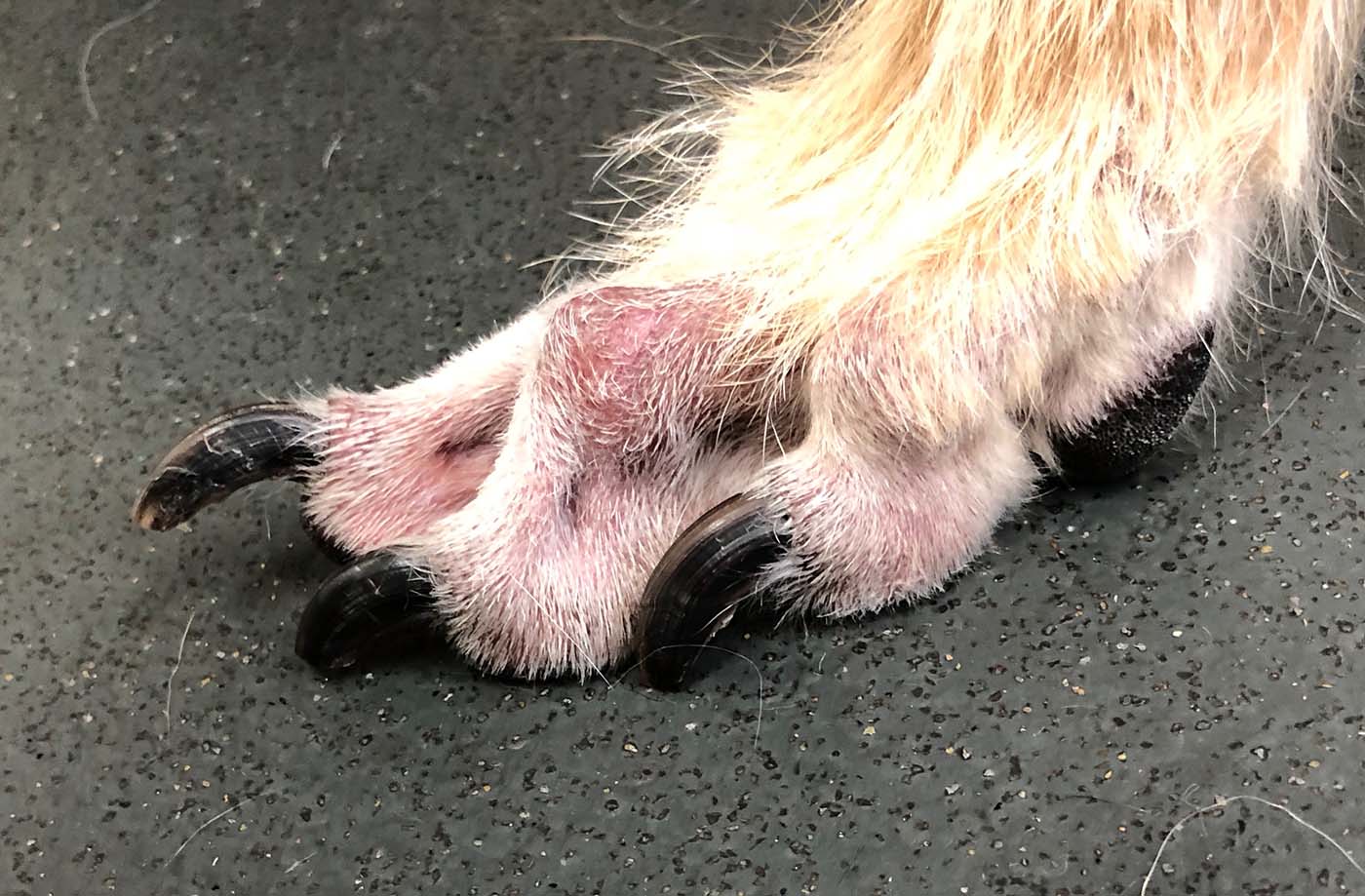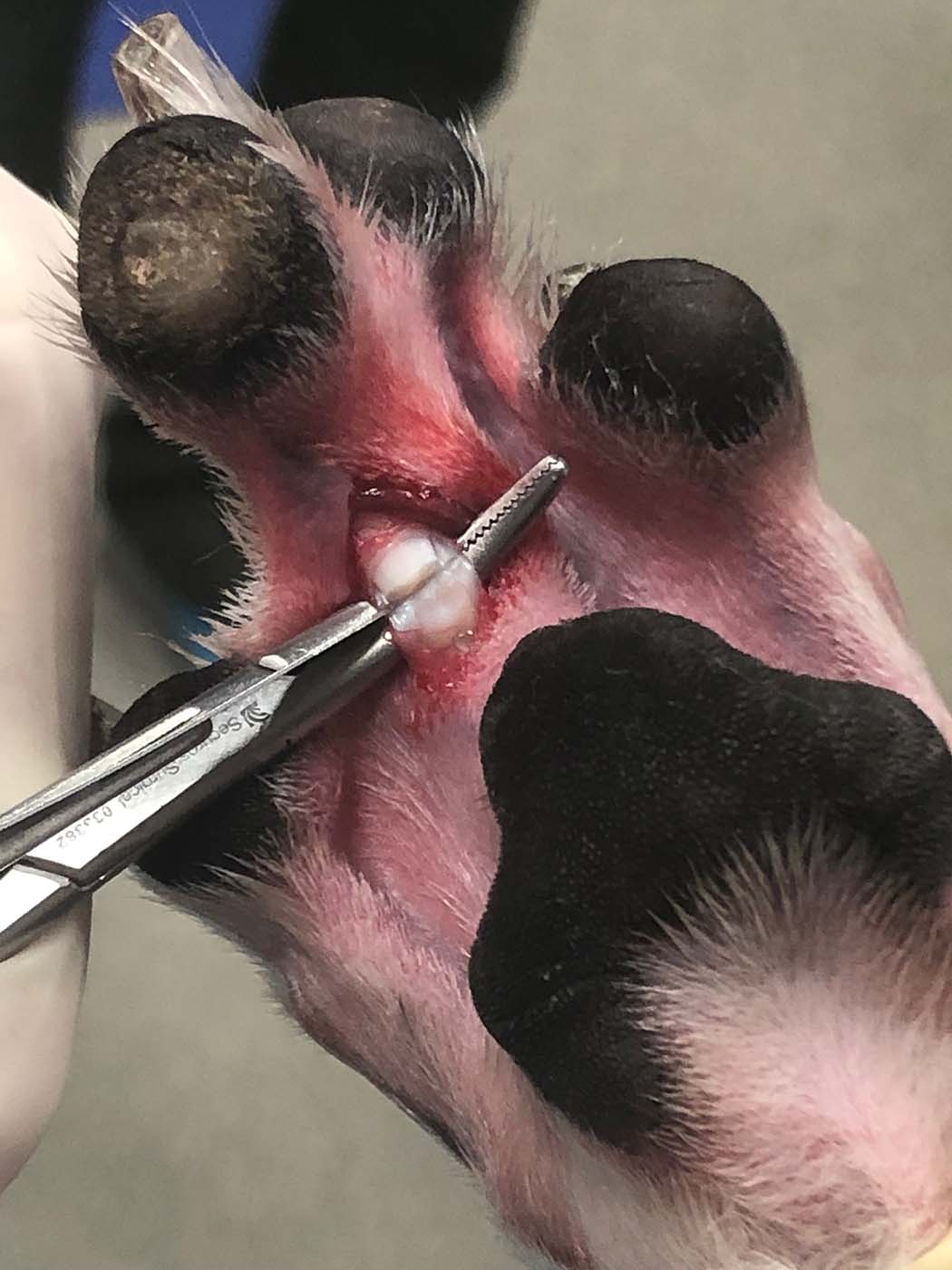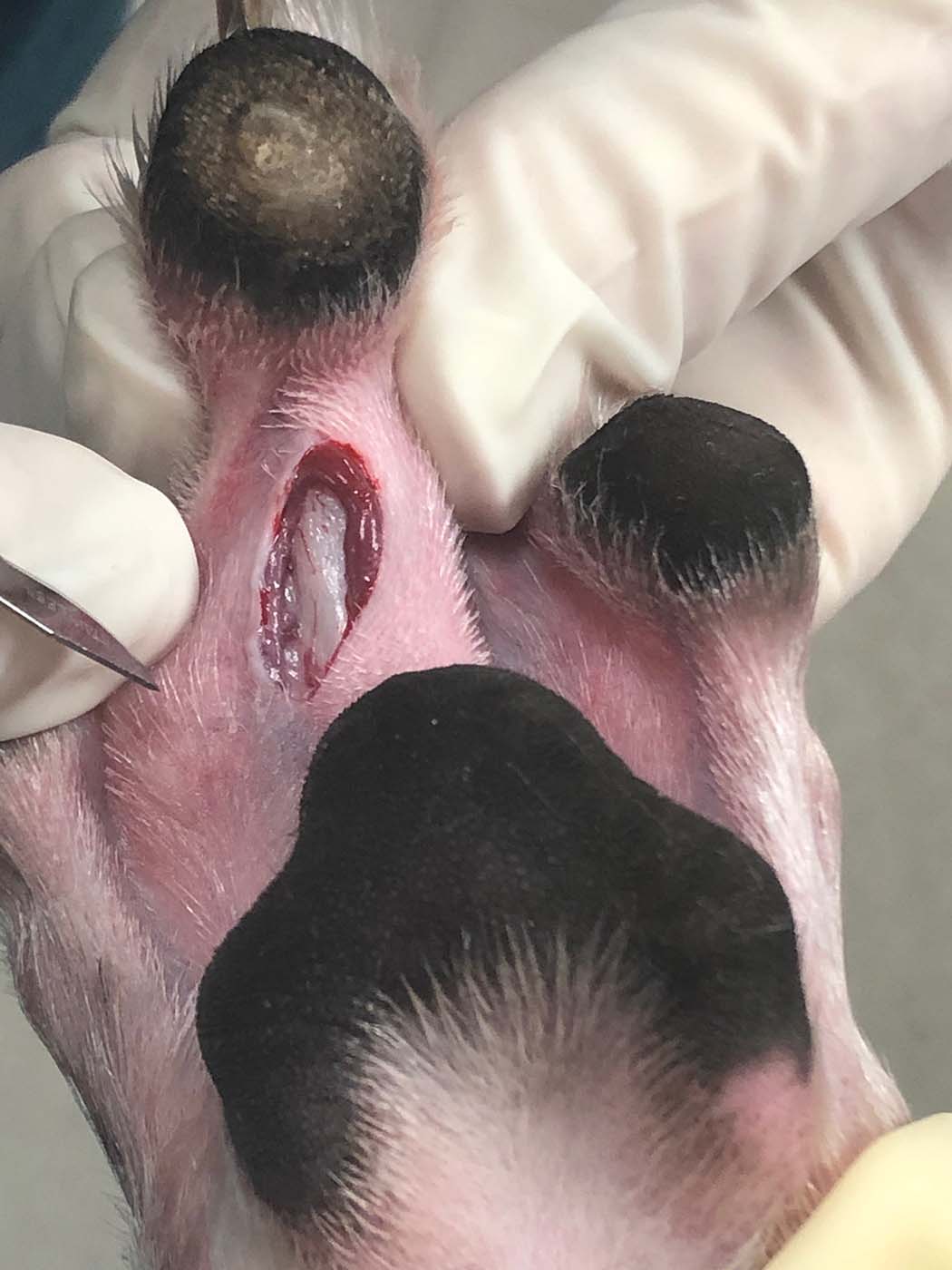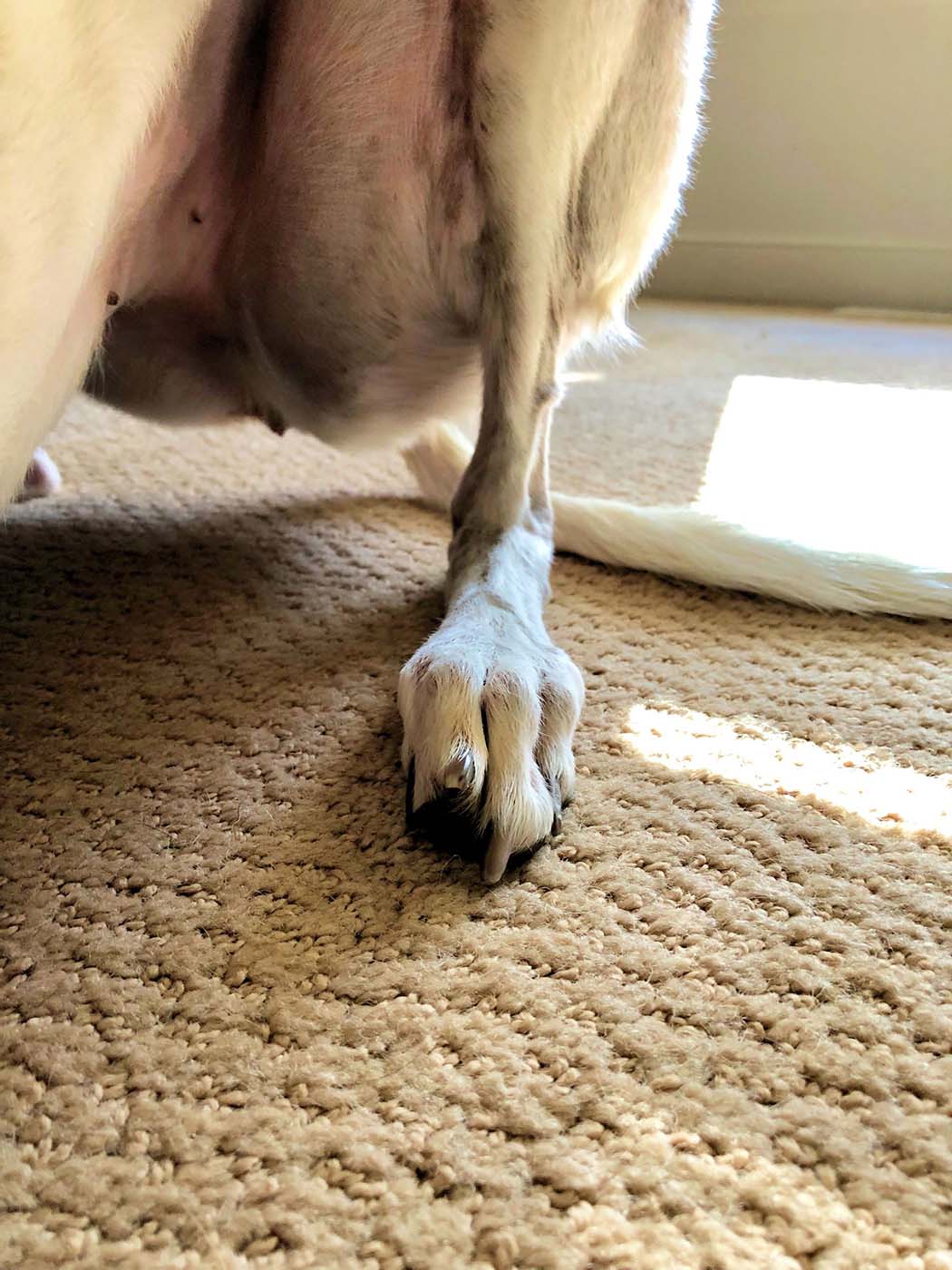Superficial Flexor Digital Tenotomy: Accepted Best Treatment for Corns

Superficial Flexor Digital tenotomy is now the accepted best treatment for corns and is performed in UK veterinary schools and veterinary practices around the world. The procedure initially involved a digital flexor tenotomy and it has evolved into removing a short section of the superficial digital flexor tendon at the metacarpus/metatarsus. Technically this is called a tendonectomy.
Short and long term results continue to be excellent but a small number of dogs have a recurrence of the corn several months after the original successful surgery due to the tendon reconnecting. Fortunately, these usually respond to repeat surgery. This is the reason for instigating the tendonectomy modification.
The following information has been obtained from the extensive research and information provided by Michael Guilliard, DVM, Richard Doughty, DVM and Bill Freeman III, DVM. For more information, please view our Corn Webinar or visit our Education & Resources page.
A corn is a hard mass of keratin, the structural fibrous protein of skin, pads, horns, and hooves; and corns are found predominantly in the digital paw pads of sight hounds. It presents as a circular area of hard pad that can protrude from its surrounding and has a deep root that impinges on the underlying flexor tendon and its bony attachment. It does not occur in the large metacarpal and metatarsal pads. Approximately 80% are found in the central digits of the forelimbs and are a source of considerable lameness especially when exercising on hard ground.
in Tennessee found papilloma virus in four corns. It would be difficult to determine why any virus would be selective to specific pads but additional research is needed. Inverted papillomatous warts have very rarely been found in the large foot pads but never in the digital pads. The cause has been attributed to foreign body penetration, virus infection (notably papilloma virus found in warts), and repeated mechanical pressure. However, X-rays of the corn have never shown a foreign body and no foreign bodies have been found over the several hundred examined histologically by Richard Doughty. No large studies have been conducted to investigate the occurrence of a virus.
It is now widely accepted that the cause is from repeated mechanical trauma focused on one area of the pad. In people, corns can be a result of tight footware or from an anatomical deformity, such as a hammer toe, and if the problem is corrected then the corn will disappear. In dogs, some form of toe or foot abnormality including flexor tendon damage, adjacent toe amputation and hyperflexed or very tight toes, has been reported in 40% of cases. The best evidence is that the corn will exfoliate and disappear if the pressure is taken off the pad.
Flexor tenotomy
The rationale for this novel surgical treatment is that by unloading the pad the lameness will immediately resolve and the corn will grow out and permanently disappear.
The flexor tendons run along the under side of the toe with the superficial tendon attaching to the bone just beyond the knuckle joint and the deep tendon attaching to the nail bone and when contracted they cause the toe to flex or curl. Cutting them prevents this action and the toe is then lifted by the action of the extensor tendon running along the top of the toe.
Results
These are the results of the preliminary study as of January 2019:
29 dogs with 36 corns were followed after surgery
Dogs: Whippet = 8; Retired racing greyhound = 17; Racing greyhound = 3; Lurcher = 1
Three dogs remained lame after surgery. All three had pre-existing conditions impacting recovery. Two of these had a digit missing on the affected foot and one had a twisted foot from a metacarpal fracture malunion. It would seem that the tenotomised digit requires support from its adjacent digits.
The remaining 26 dogs showed improvement at seven days.
At seven days, three were assessed as moderately improved and 23 as greatly improved in perceived lameness and well-being.
At the six- to eight-week follow up, 21 dogs with 26 corns were examined. Four dogs had slight lameness and the remaining 17 dogs showed no lameness. When reviewing owner satisfaction, all owners very satisfied with the outcome. The dogs were much happier and willing to exercise normally. All corns had grown out/disappeared by this time.
One racing greyhound with bilateral thoracic limb corns returned to the track in 25 days and raced very successfully.
Discussion
In the three failures the corn disappeared in two cases but the resultant lameness was soreness on the underside of the dropped toe as there was no support from adjacent digits.
Long terms results are unknown but dropped toes are not uncommon in racing dogs and usually do not cause a clinical problem.
One question frequently asked is the possibility of further digits on the same foot developing corns and the answer is probably very unlikely but there is no evidence for that yet.
Flexor tenotomy has given excellent results to date and taken these dogs out of pain giving them back a great quality of life.
Other Treatments
There are many as is often the case when there is none that gives reliable results.
- Conservative management: the protruding hard tissue is regularly filed down and a protective boot fitted https://www.therapaw.com
- Lotions and creams: these consist of chemicals that will dissolve, soften or burn the corn and again will need regular applications.
- Excision is a surgical procedure that removes the entire corn with suturing of the pad. Amputation of the last joint preserving the pad.
- Hulling is popular and involves digging out the corn with a dental elevator
- Amputation of the entire digit.
- Superficial Digital Tendonectomy with or without an additional digital tenotomy.
Complete surgical excision has been shown to give the best long term results but about 50% of corns will have recurred in a year.
The reason for the failures is that the underlying anatomical cause has not been addressed and in many cases this will not be obvious as it can be a result of previous injury, degenerative change of possibly conformation as seen with corns appearing in the same digit on both fore feet.
The ultimate treatment is amputation of the entire digit permanently removing the problem and it usually has no untoward consequences.
Additional resources and home treatments can be found on the https://www.facebook.com/groups/Greyhoundswithcorns/
Additional photos and research data have been published in Veterinary Practice News Canada.
Published on
11/04/2018





